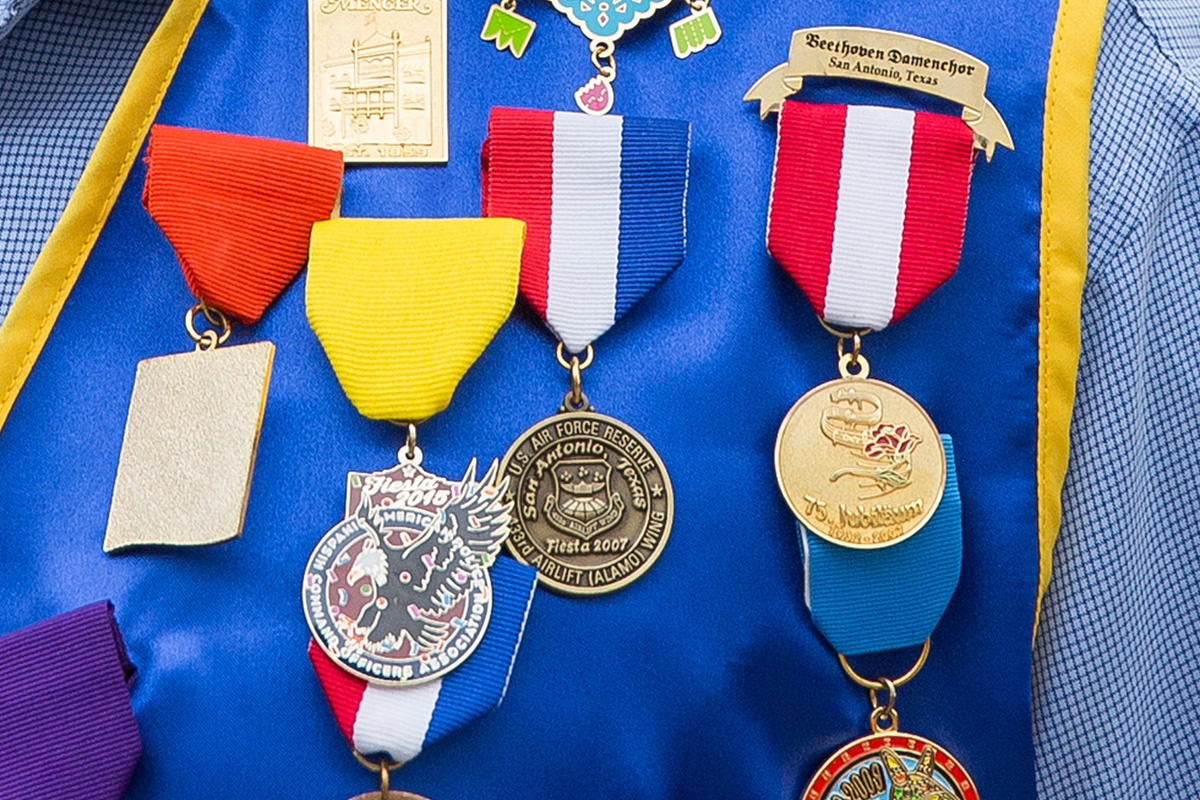Almost everyone in San Antonio wants Fiesta medals. People are crazy for them. The small colorful metal or plastic pendants are handed out by organizations and individuals and worn on sashes, shirts, vests and hats, promoting the cause to the world.
“I collected 270 [medals] by the time Fiesta started,” says Anna Catalani, a former Fiesta volunteer. “People start coming (to the Fiesta store) in January to buy a few medals at a time.”
The medal tradition has foggy origins. Some say it began in the 1960s when people began wearing coins with a decorative cardboard frame handed out by Fiesta royalty. Others claim King Antonio XLIX made the first “official” Fiesta medal when he punched holes in his coins and added ribbons by hand in 1971. Whatever the origins, military institutions, businesses and universities picked up the idea in the 1980s. By the 1990s, the costs of production were low enough that even individuals could afford to create their own medals, today paying about $400 for 100 medals of their own creation.
Medal mania is now full-blown, with design competitions, an official Fiesta market day for trading, and a Pounds of Pins competition. Marcus Rosales, the 2015 winner, collected 1,948 pounds of medals, all from a single season of Fiesta. Some medals are sold to raise money for charity; some are sold for their artistry; but most are traded face-to-face.
Eddy de la Garza, known as “Mr. Fiesta” to his friends, has been collecting Fiesta medals seriously since the 1980s. He owns more than 1,000, some going back to those early cardboard-framed coins of the 1960s. “New Orleans has the beads, but San Antonio has the medals,” de la Garza says, explaining the mania for the trinkets.
“I always trade medal for medal,” says de la Garza, who created his own in remembrance of Joske’s department store, a beloved San Antonio business that was demolished in 2014. “The best medals are a San Antonio landmark or something that makes you remember your childhood,” he says. Among his favorites a rare 1989 Fiesta Commission medal of two colorful kites with streaming ribbons, a medal from Tommy’s Restaurant honoring Big Red soda and barbacoa tacos, and another commemorating the Spurs’ NBA championship in 2014.
De la Garza likes the way the medal trade gets people talking. “You go up to someone and you say, ‘Hey, I like that medal. Can I trade you something for it?” he says. Sometimes they don’t want to trade, or they want your medal but don’t have anything you want in return. De la Garza explains that either way, you are talking to someone, meeting a neighbor and making a connection. Collecting medals means you are out looking, asking, admiring and participating.
“If you want to win the contest, you have to hustle,” says de la Garza. “You have to go to all the events, and there’s a lot of them.”
——————–
Julia Robinson is an Austin photojournalist.

